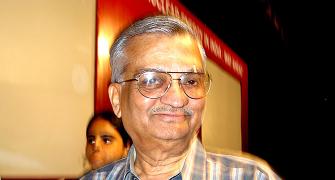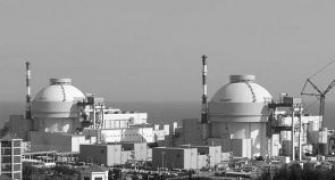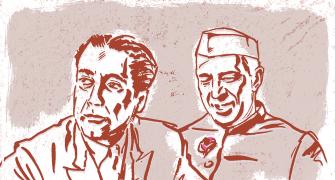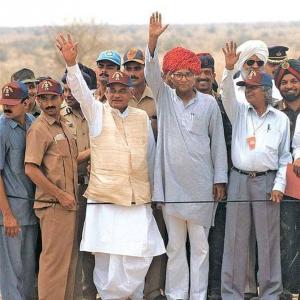'Why should we disclose classified information. to satisfy those who doubt our Hydrogen Bomb capability?'

Dr Anil Kakodkar was chairman of the Atomic Energy Commission from 2000 to 2009, during which India signed the civilian nuclear agreement with the United States. Before that, from 1996 to 2000, he was director of the Bhabha Atomic Research Centre, a period during which India conducted two nuclear tests in May 1998.
"In my view, doubts about the success of our thermonuclear test in 1998 are raised to seek more and more information from us. No country has shared as much technical information as India. But their 'dil mange more', I sensed that game even at that time. So I concluded that getting into this 'tu tu, mein mein' is futile," Dr Kakodkar, 80, tells Shivanand Kanavi in the first of a two-part exclusive interview.
Ashley Tellis, the American strategic analyst of Indian origin, suggested recently that China and America may conduct nuclear tests again and that may give a window of opportunity for India to test and modernise its nuclear arsenal and particularly its thermonuclear designs which according to him 'fizzled out' in 1998, despite Indian claims to the contrary.
What is your view about the doubts raised about thermonuclear tests in 1998 as well as a possible window for testing again?
In my view such doubts about the success of our thermonuclear test in 1998 are raised to seek more and more information from us.
Although in terms of publicly sharing information about nuclear tests, no country has shared as much technical information as India. But their 'dil mange more', I sensed that game even at that time. So I concluded that getting into this 'tu tu, mein mein' is futile.
I asked my colleagues, after these doubts to develop a 3-D model, to look at the rock movement consequently shock, arising out of a nuclear blast.
These movements are different from a normal blast because the strain rates are high, hence the equations to be used are not the same.
Mind you at that time, nobody had developed such a model, including in the US.
Outsiders cite the profile of a test site from satellite pictures after the test and the teleseismic data from some earthquake monitoring stations like they have in Uppasala, Sweden, etc to talk with so much confidence and create doubts about our claims.
So to call that bluff, I said. We not only developed a 3D model but also qualified by using data from Baneberry test (external link) in the US which unfortunately had vented -- leaked radiation.
Because it had vented there was an enquiry and hence a lot of data came out in the public domain.
So we used the Baneberry data and our predictions and sent a paper to a well-known US journal.
The journal referees would keep asking questions 'Ye kidhar se mila vo kidhar se mila?' It was taking time.
Then suddenly a paper appeared from the Lawrence Livermore laboratory (the main lab in the US which has been involved in nuclear weapons R&D for many decades) about a model and their calculation.
So it was clear that the referees of the journal we had sent our paper to had some connection with Lawrence Livermore.
Basically, they did not want Indians to get the credit for developing such a model first.
So we wrote to the editor, 'You are free to review for as long as you wish. Take as much time as you wish. But you have to write both the dates. The date it was communicated and the date of publication.' They were honest enough, so even though it took two years for them to accept it they did publish the date we had sent the paper for publication correctly.
I'm just telling you the politics and the mindset, technical people are not without these afflictions (laughs).
That was to establish that we have that kind of modeling and computational capability.
Then we said that now use that code which we can claim is qualified and do a lot of numerical experiments.
I detonate something in a loose soil, in a cavity etc and what kind of teleseismic signal will I get? But they sit in Uppasala or somewhere and say it was 5 kilo ton and not 15 kilo ton etc arbitrarily and confidently.
We published to shut their mouth. Then the question was the profile of the crater on the ground at Pokharan.
So let us calculate that again, but we cannot publish a paper because we can't say the depth of placement and other classified data.
So we just calculated the contour, for both the fission and the fusion thing. And showed that it matches with what is there on the ground!

But why this curiosity? They think we have innovated something and want more disclosure?
Well, that could be one reason, but also many people are making a living out of this.
That's okay, nothing wrong with that. So I refuse to get into that debate.
As for a window to test again, let's see when it appears, the country can decide.
I have nothing to do with it anymore. So that question of India testing again according to me is a non question.

Does our nuclear liability law need a change? There were some complaints when it was passed at that time. But in a private conversation with me recently you said 'it's sui generis and let others use it as a model'! So what is the issue?
The nuclear liability framework evolved in the US. Its objective was to protect its nuclear industry.
So the so-called standard template is with that in mind.
Now we also knew that. Now that we were talking about civil nuclear cooperation.
We had to develop a nuclear liability framework, so we have got some people to study these issues, including at the National Law School in Bengaluru, etc.
Then around that time, the Bhopal Union Carbide court decision came.
Mr Warren Anderson, CEO of Union Carbide, was nowhere to be seen and the mood in our Parliament was 'These Americans cannot be trusted. How do you protect our people?' So that is the genesis of our nuclear liability framework.
So we tightened the suppliers' liability part.
The point is, if you are in the process of making some law, you want to make it tighter.
I did say at that time some of the changes we were doing are not consistent with the international framework.
But that's past. Now our Parliament has passed it.
So I started telling the Americans, 'look bhaiya, for you American laws are supreme, for me Indian laws are supreme.'
Everything can be discussed till the law is passed, but once it's passed we have to follow that. That's all.
Moreover, why should we follow the American pattern? Because whether it is liability connected with any airplane crash etc, an American life is always valued at a much higher level compared to others. Just because the fellow has more money, his life is more precious! Somebody who has no earnings you will say he can die like a dog. This is not correct.
So now I maintain that perhaps in terms of protecting the public, our law is superior. Perhaps that should become the common template for international law.
Anyway, that is only for an academic discussion. Some people are unnecessarily making it the issue.
If it is established that any mishap was because of a suppliers' fault, then they should compensate, and moreover, there is a due process of establishing fault or refuting.
We also have an insurance mechanism now.
Opening up international nuclear cooperation was an important thing. And we have complied with every requirement of that.
Their lawyers can always find a solution if they want. I don't give too much importance to that. It's their problem. They will sort it out. They can't take Indians as guinea pigs.

Has our nuclear liability law become, an obstacle in negotiating nuclear reactors with either Areva (France) other Western companies or Rosatom (Russia)?
If you ask them, they will say yes. But the real obstacle is Westerners' costs are too high.
Once the price part is sorted out, the deals will go through.
We sorted it out with the Russians! Western companies are hiding the fact that their costs are high and they still want Indians to buy their reactors. Indians say, 'First you bring your cost down, then we buy'. We don't want another Enron to happen!

The Prototype Fast Breeder Reactor representing the second stage of the Indian nuclear programme has been delayed by about 10 years. In one of your public lectures, you talked about the number of papers published on Fast Breeder Reactors, Thorium R&D, etc, and had claimed that we are at the cutting edge in all these things. Is that still true R&D-wise?
Yes. R&D is going on. We need to get into a project mode as far as our new design of Advanced Heavy Water Reactor in 2005 (external link) SMR (Small Modular Reactor) has become a buzzword today, but our 300 MW AHWR could do all that and maybe 20 years earlier.
We didn't properly project AHWR's safety aspects etc. that's a different story. After all, the purpose of SMR is to be able to locate anywhere safely.

Recently there was an announcement about a 4th generation nuclear reactor from China. Can you please explain what is this 3rd generation and 4th generation in safety terms?
These are terminologies that came essentially around the first decade of the 21st century.
Many countries started realising that nuclear power has stagnated, so what are the barriers to growth and how to overcome them? They said, 'Let us create systems that are safe, guarantee sustainability, do not create waste management issues etc.'
That was much before the Fukushima accident in Japan in 2011. Japan was also talking about all new systems and their nuclear industry had a large number of variants of different designs.
The Germans and French were also involved at that time, though the Germans withdrew later.
So they created what is known as the Generation 4 International Forum (GIF). They offered us also, that India could also be a part of this.
I was sceptical about it because there are IPR issues and several countries cannot develop new technology together smoothly. Now GIF is practically extinct.
I was quite sure that we could do it ourselves. So we went ahead with our AHWR design and R&D.
Today our AHWR would qualify for generation 4. Way back we had asked the Russians to upgrade the Kudankulam reactors and you can now call them Generation 3 Plus.
Our own 700-megawatt units at Kakrapar (near Surat) and others under construction are also generation 3 Plus.
The Chinese generation 4 is of a much earlier origin. They have been working on high-temperature reactors which can be one of the generation 4 systems.
A lot of money has been spent, but others are only talking. The Chinese have been pursuing that system much before GIF came into existence.
The Chinese are not a part of GIF. But today, that is the only generation 4 system.
- Part II of the Interview: 'Nuclear Has To Get Into Achche Din'
Shivanand Kanavi is a former VP at Tata Consultancy Services and former executive editor of Business India. The award-winning author of Sand To Silicon: The Amazing Story Of Digital Technology is also adjunct faculty at the National Institute of Advanced Studies, Bengaluru and frequently contributes to Rediff.
Photographs curated by Manisha Kotian/Rediff.com
Feature Presentation: Rajesh Alva/Rediff.com









